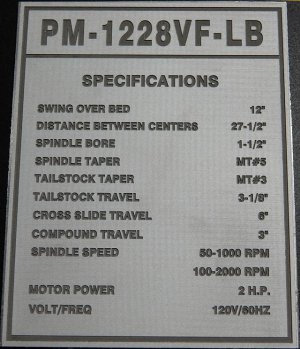This is an infrared pulsed fiber laser with a wavelength of 1064nm. 50 watt version.
But back to the ID label I am working on,
Your label looks pretty nice!
However, I am a little surprised you are getting much of an engraving process at all. Metals, SS and Al, are pretty reflective at this wavelength. You need a wavelength that is absorbed by the substrate material. For metals this is typically in the blue or UV (<~ 400-450nm nm = 0.4 micron), not the infrared (1064nm = 1.064 micron). However Nd:YAG solid state lasers (also 1064 so the fiber probably has the same or similar material in it) have been used for many years, before the Fiber lasers for resurfacing. However, it is not uncommon to frequency double or quadruple the YAG laser frequency to get them down in to the green or UV wavelengths for better absorption. Since the light that reflects off of Al or SS is pretty color free it indicates that it is not absorbing at the visible wavelengths much at all. Once you have an absorbing wavelength and sufficient power densities, then the metal surface will ablate off rather than just heating to metal ... or to react with the oxygen/water/or what ever else is in the air at the surface. They sometimes "cut" metals with really powerful, big CO2 lasers (~10 micron wavelength), but they are always flooding the surface with O2... so the melted metal is oxidizing fast and being blasted a way. The 10 micron wavelength is pretty good at being absorbed by water and this is why they use the CO2 in wood (carvings) and for cutting many layers of fabric at one time.
The Al is a much better conductor than SS and so when you heat it locally the heat is being distributed over the metal better than it is when the surface of SS is heated. Uniform heating means the substrate is less likely to warp. So maybe you are seeing this. Warping implies you have induce stress in the surface. Depending upon the curvature, the laser process surface is either expanded or contracted. I ran in to a similar warping when I machined the surface off of a sheet of Al to make the sheet thinner. I then clamped it flat and put it in an oven for a few hours to relieve the stress. It then came out flat.
Removing the material from one side introduced sufficient stress to bend the plane into a potato chip shape. Clamped it between a couple of pieces of steel plates with C-clamp to flatten it, and then put in to an oven at over 400F for a couple of hours. Came out flat after this stress was released by this anneal.
You could paint the surface and then run the laser over the surface to remove or react the paint and get the pattern. However, how durable is the paint that is left behind. I have never done it by my understanding is that SS surface can be made black by oxidizing it to the proper FeOx state, i.e. Fe2O3 vs Fe3O4. To do so I think you take it to a very high (glowing red) temperature and then plunge it into an organic coolant (oil) which probably breaks down and reacts with the surface. This surface you could then probably treat it as though it had been painted on. However, once again this oxides is probably thin and may wear.
By the way, copper and bronze are somewhat red/orange telling us that this material reflects in the red/orange wavelengths (and near IR) and absorbs in the blue green wavelengths.
Your fiber laser is pulsed and the time interval between pulses is probably much longer than the actual pulse length. This means that the the instantaneous power level is probably much higher than the power rating, which is usually the average power. Assuming that the pulse length is 0.1 microsecond and that the rep rate is 100,000 pulse per second ( 10 microseconds between pulses) this means a duty factor of 0.1/10 or 0.01. Hence the peak power should be 100 times the average power. This helps to make fast reactions occur but if it boils down to just heating the metal and then having react with the air, the diffusion of the heat away from the spot can become dominate. In your U-tube video the laser light was causing flash of light so there is some sort of reaction occurring.
It all kind of makes me wonder what you would get if you were to mist the SS with a bit of oil (carbon and oxygen source) while you were running the laser. It is probably messy and may screw up your optics?
If there is any interest, take a look at the following patents where the surface of hard disk substrates were laser processed to produce a long wear (low friction) surface. Since that time folks have use similar processes for many other applications including reduced wear in human artificial joint surfaces.
Magnetic recording media are controllably textured, particularly over areas designated for contact with data transducing heads. In connection with rigid media, the process includes polishing an aluminum nickel-phosphorous substrate to a specular finish, then rotating the disc while directing...
patents.google.com
Magnetic recording media are controllably textured, particularly over areas designated for contact with data transducing heads. In connection with rigid media, the process includes polishing an aluminum nickel-phosphorous substrate to a specular finish, then rotating the disc while directing...
patents.google.com
Dave L.


